.png)
Hello everyone, I am happy to be in Season 4 of Crypto Academy. Let's continue to work for the development to this community together.
In this assignment, after explaining what Harmonic Trading is, I will talk about the AB-CD pattern, which is one of the Harmonic Patterns, and try to use this pattern with the Fibonacci Retracement and show it with some examples. I wish you pleasant reading.
In crypto and other financial markets, traders try to make money by blending certain rules, patterns and price movements. Prices continue on their way by making ups and downs in accordance with their nature. What a good trader needs to do is to analyze these price movements well and combine the knowledge he has learned with his experience and enter the trade. The trader needs to improve himself in many aspects. First of all, he must know basic and technical analysis well and apply what he has learned well. In addition, managing the psychology of money will not be easy. The trader who can do all these will be a successful trader.
There are many models available for the trader to use. Now, I will talk about the Harmonic Model, which has been used in financial markets since the past.
1. Define in your own words what harmonic trading is.
2. Define and explain what the AB = CD pattern is and how we can identify it.
3. Clearly describe the entry and exit criteria for both buying and selling, using the AB = CD pattern.
4. Make two in between (Raise and Lower) on any pair of cryptocurrencies using the AB = CD pattern confirming it with Fibonacci.
When you open and look at a certain chart in the financial markets, the movements that appear in front of you consist of rises and falls. Traders prefer to buy if there is a upside trend and sell if there is a downside, because the natural method is assumed. It is assumed that this natural cycle in the markets is very similar to the cycle in life and constantly repeats itself within certain rules. That's why Harmonic Patterns are applied to the financial market by taking the development process of nature as an example and successful results are obtained.
Harmonic Patterns takes this natural cycle of the market into account, installs the Fibonacci Retracement within this cycle to calculate the retracement points according to the direction of the trend, and determines the entry and exit points of the trade to be made. In other words, it allows you to recognize certain prices in the cycle of the market and aims to make a profit in the market that tends to repeat itself. Because past price movements give clues about future price movements.
- When did Harmonic Patterns emerge?
Harmonic Patterns first appeared in HM Garthly's book "Garthly Exchange" in 1932. In the following years, this model was developed by Larry Pesavento with the Fibonacci Retracement.
There are some formations in Harmonic Trading. These;
- Crap Harmonic Pattern
- Bat Harmonic Pattern
- AB=CD Harmonic Pattern
- Gartley Harmonic Pattern
- Butterfly Harmonic Pattern
- The Three Drives Harmonic Pattern
- The Shark Harmonic Pattern
Now that we're talking about Harmonic Patterns, let's move on to the AB=CD model, which is one of the formations in it.
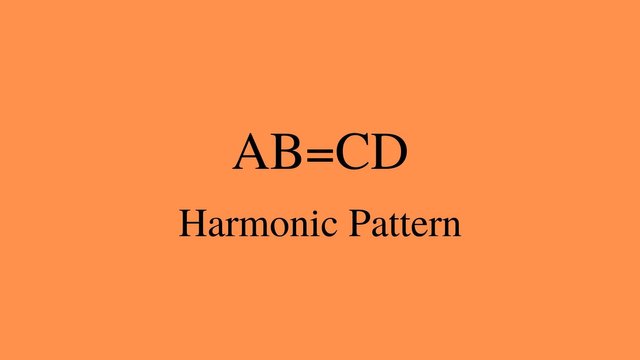 Photo has created by me from Canva
Photo has created by me from CanvaTrends in the markets continue up to certain levels. Whether its direction is up or down, it will retest some points at certain points. This is called the natural cycle of the market. After these price movements, called corrections, are over, the price will continue towards the trend direction again and the point where the price will go does not change until the trend ends. This model we will talk about is like two legs being equal to each other.
The AB=CD model consists of the interconnection of 3 different price movements. The starting point of the price is A, the point at which it will stop first according to the direction of the trend is B, the price point at which it will correct from this point is C, and the last point at which the direction of the trend will be completed is D.

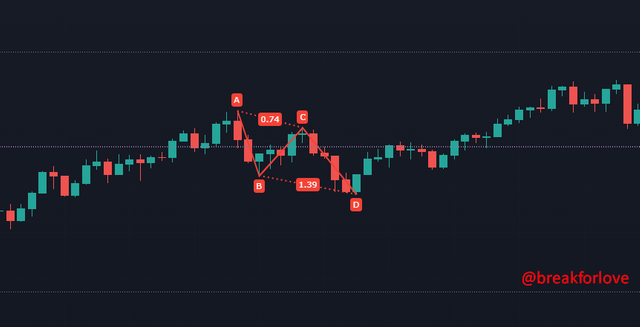
AB=CD Pattern has some rules. These rules;
- In the price movement between AB, point A is the lowest and point B is the highest. If these points are exceeded, the pattern is invalid.
- Point C, known as the correction point, must be higher than point A.
- If these points are exceeded in the price movement between BC, the pattern is broken.
- Point C should always be between 61.8% and 78.6% when the Fibonacci Retracement of the price action between AB is taken.
- The D point that will occur after the correction at the C point must be higher than the B point.
- Point D should always be between 127.2% and 161.8% on the Fibonacci Retracement of price action between BC.
Everyone's balance and risk are different. The important thing is to manage money. You know that the easier it is to win, the easier it is to lose. Therefore, it is always useful to make a good analysis. Now let's talk about how we can log in and out using this model.
I mentioned that we have to follow some rules when using the AB=CD model. The first of these rules is that we have 4 dots. But they don't all happen at the same time. First we determine a point A. Price action from this point A will visit points B, C and D respectively. If this trend is making an uptrend,the Fibonacci Retracement drawn between the D point and the BC points should be between 127.2% and 161.8%. A red candle that will open at this point confirms that we need to place a sell order and creates a profit margin until the next correction.
A point A determined will form points B, C, and D, respectively, while forming a downtrend. If point D is between 127.2% and 161.8% of the Fibonacci Retracement between wave BC, this is taken as a signal for uptrend and traded in the bullish direction.
It is ideal to put 2% - 3% Stop Loss after point D in both directions. After all, no formation guarantees 100% success. The important thing is that the trader's loss should not affect his balance too much.
The TP1 point can be taken in the first leg of the next correction. This region is usually the correction from point D to point B. Price action in both directions is expected to correct again. Then, if the price continues in the trading direction, it can reach the next TP points.
- Bearish AB=CD Harmonic Pattern

In the screenshot above, there is a rising price action from point A to point B. We also see a correction movement consisting of point B. The correction ends at point C. When we pull the Fibonacci Retracement between AB price action, we confirm that the C point is between the 61.8% and 78.6% levels.
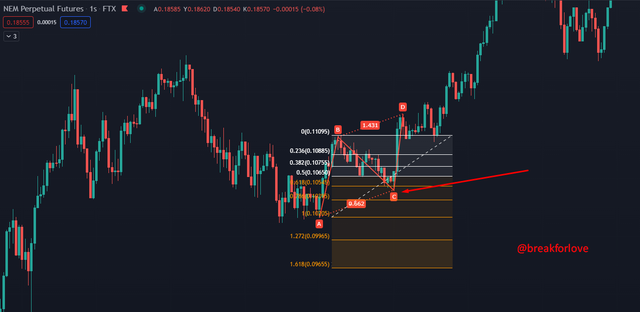
When we use Fibonacci Retracement between B and C points, we see 127.2% and 161.8% levels. In the continuation of the move, the price completes the D point exactly where it was predicted. Here, a correction towards point B can be expected by taking a sell position and placing a 2% stop loss. Point B is ideal for exiting the trade. In the example on the chart, the correction is completed at point B and the price is making another small rise.
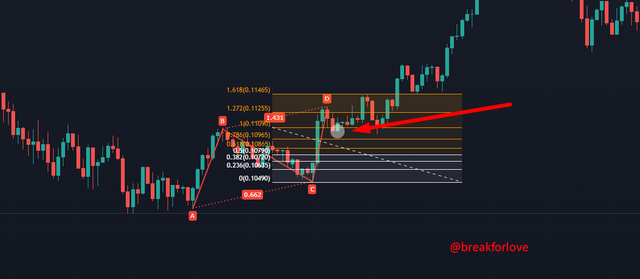
- Bullish AB=CD Harmonic Pattern

As we can see on the chart, the price starts a downtrend between the AB point. Then the price makes a correction of the decline and comes to point C. When we draw Fibonacci between AB, we see that the 61.8% to 78.6% region coincides with the C point.
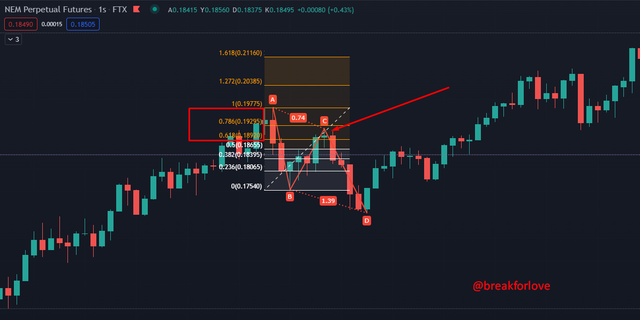
In the continuation, the price continues its downtrend as predicted. The 127.2% and 161.8% levels of the Fibonacci Retracementdrawn between the BC point coincide with the D point. Since the price is likely to rise from here, an uptrend can be opened with a 2% SL distance. The first TP point I mentioned corresponds to the B level, which creates a profit margin of 3.98%.
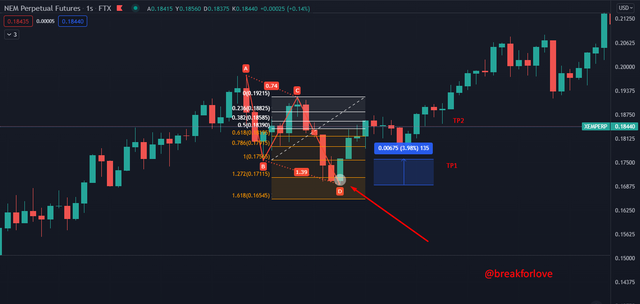
Harmonic Patterns continue to be used, supported by the Fibonacci Arrangement for a long time. If the resulting geometric pattern structures are analyzed well, it is said to have a success rate of 70%-80%. This model may not be very useful as some markets are horizontal (ex: foreign exchange markets), but forex and crypto markets are markets where harmonic patterns give better results. In order to increase the success rate, we must predict the direction of the trend well and determine our entry and exit points using Fibonacci.
Thank you for reading.
CC: @lenonmc21
